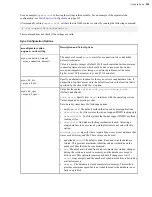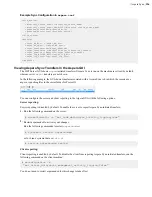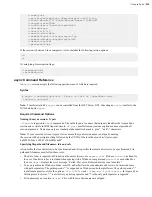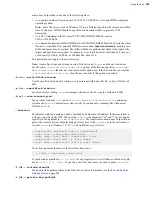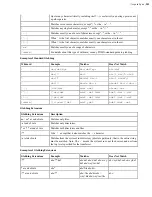
| Aspera Sync |
236
Instance Options
-A, --version
Display the
async
version information and license information.
--apply-local-docroot
Prepend the local
docroot
to the local directory.
-D[D..]
Log at the specified debug level. Default is 0. Additional Ds return more messages.
-h, --help
Display help for command-line options.
-L
log_dir
,
--alt-logdir=
log_dir
Log to the specified logging directory on the local host. If the directory doesn't exist,
async
creates
it for you.
-q, --quiet
Disable all output.
--watchd=
datastore
:
host
:
port
[:
domain
]
Use asperawatchd connected to the specified Redis for the transfer session.
datastore
can be
redis
or
scalekv
.
For example:
--watchd=redis:localhost:31415
The optional
domain
argument allows you to specify if the domain is other than the default root.
For more information see
Using the Aspera Watch Service with Aspera Sync
on page 257.
Session Options
-a
policy
,
--rate-policy=
policy
Transfer with the specified rate policy.
policy
can be
fixed
,
fair
,
high
, or
low
. Default:
fair
--assume-no-mods
Assume that the directory structure has not been modified. If a directory's modification time has not
changed compared to the Aspera Sync database,
async
in non-continuous mode skips scanning the
directory. This option makes scanning static directory structures faster. Aspera recommends using
--exclude-dirs-older-than
instead of this option.
-B
rdbdir
,
--remote-db-dir=
rdbdir
Save the remote database to the specified directory. Similar to
-b
, but applies to the remote
database. For further usage information, see
on page 228. Default:
.private-asp
at the root level of the synchronized directory. The directory is created if it
does not already exist. If
<async_db_dir>
is set in
aspera.conf
on the server, that setting
overrides the location specified with
-B
.
-b
ldbdir
,
--local-db-dir=
ldbdir
Use the specified local database directory. Default:
.private-asp
at the root level of the
synchronized directory.
You can save the Aspera Sync database to a different location than the default one under the
ldir
specified with
-d
. This allows you to store the database away from the main data files, which is
useful for performance tuning. It is also useful when
-d
ldir
is located on a network share volume
that does not reliably support database locking. For more usage information, see
on page 228.



